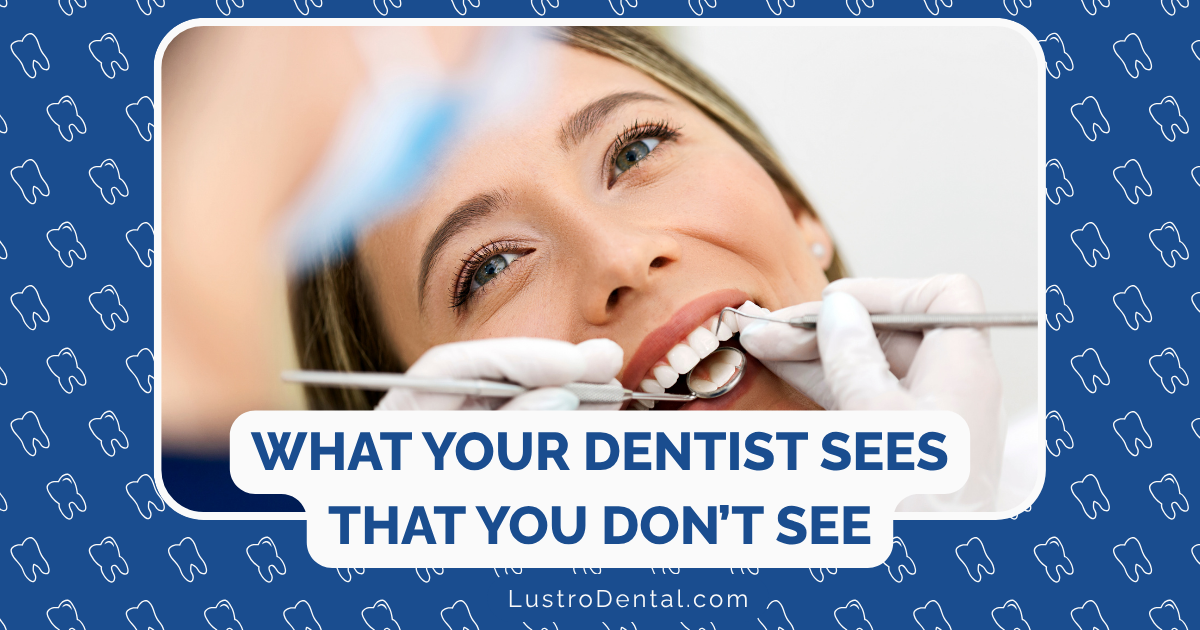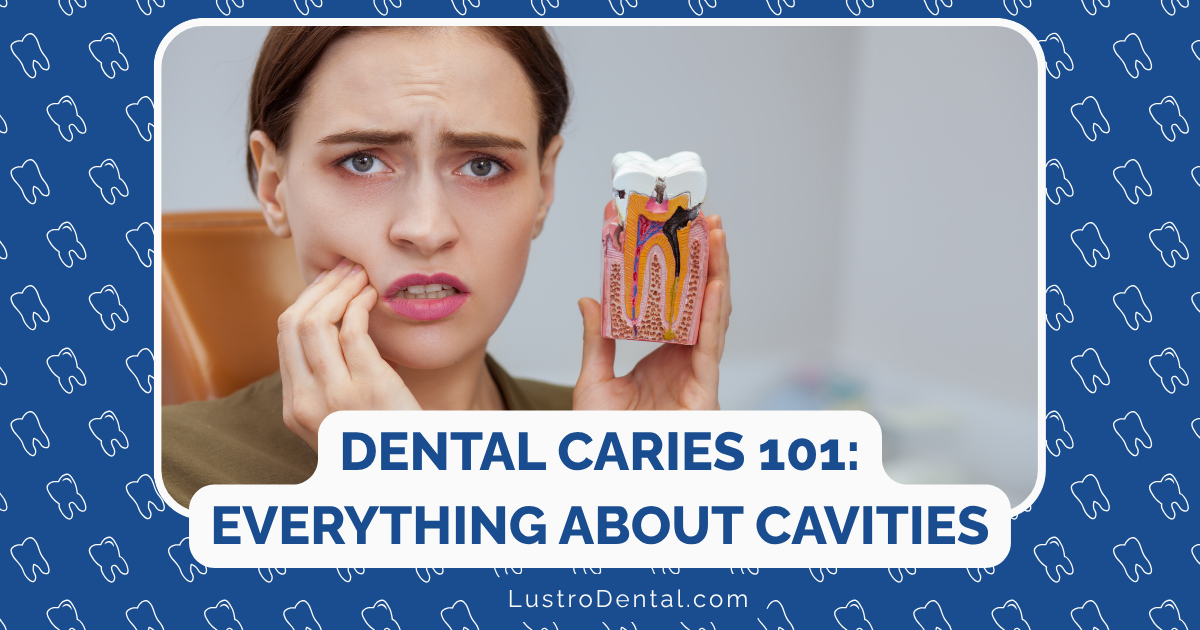What Your Dentist Notices During Your Routine Exam (But You Can’t See)

That routine dental checkup you might be tempted to skip? It’s far more than just a cleaning and a quick peek at your teeth. While you’re in the chair, your dentist is conducting a comprehensive assessment that extends well beyond looking for cavities. In fact, those trained eyes are picking up on subtle signs and symptoms that could reveal important information about your oral and overall health—things you’d never notice yourself.
In this eye-opening guide, we’ll pull back the curtain on what dental professionals are really looking for during your exam, and why those observations might be more important than you realize.
Beyond the Surface: The Hidden Landscape of Your Mouth
When you look in the mirror, you might see teeth that appear healthy. But your dentist sees a complex ecosystem with numerous indicators of health and disease.
“The mouth is like a window to the rest of the body,” explains Dr. Sarah Chen, a periodontist at Columbia University. “We can see signs of systemic conditions, nutritional deficiencies, stress, and of course, oral diseases—often before the patient experiences any symptoms.”
Let’s explore what your dentist is actually examining during those seemingly routine checkups.
1. The Early Stages of Tooth Decay (Before Cavities Form)
What you might notice: Nothing, until a cavity has progressed enough to cause sensitivity or pain.
What your dentist sees: The earliest signs of demineralization—white spots or slight discoloration that indicate enamel is beginning to break down.
“We can detect decay 12-18 months before it would become a cavity requiring a filling,” notes Dr. Michael Rodriguez, DDS. “At this early stage, we can often reverse the process with fluoride treatments and improved home care, saving the patient from needing more invasive procedures.”
Using specialized tools, dentists can detect:
- Areas of enamel that feel slightly softer than surrounding areas
- Subtle changes in tooth translucency
- Microscopic pits where bacteria are beginning to erode enamel
- Staining patterns that indicate areas at risk
According to research published in the Journal of the American Dental Association, early intervention for incipient lesions can reduce the need for fillings by up to 70%.
2. Hidden Infections and Abscesses
What you might notice: Perhaps some mild discomfort, or nothing at all in early stages.
What your dentist sees: Subtle changes in gum tissue color, minor swelling, or small fistulas (pimple-like bumps on the gums) that indicate infection brewing beneath the surface.
“Many dental infections begin painlessly,” explains dental hygienist Jennifer Marsh. “By the time a patient feels pain, the infection has often progressed significantly. During routine exams, we look for tiny signs that something’s not right—like a slight redness above a tooth root or minimal swelling that the patient wouldn’t detect.”
X-rays reveal even more, showing:
- Dark spots at root tips indicating abscesses
- Bone loss around teeth roots
- Widening of the periodontal ligament space
- Thickening of the sinus membrane above upper molars
Early detection of these issues can mean the difference between a simple procedure and a dental emergency requiring root canal therapy, extraction, or even hospitalization for severe infections.
3. Signs of Grinding and Clenching (Bruxism)
What you might notice: Perhaps occasional jaw soreness or headaches.
What your dentist sees: A pattern of wear that tells a detailed story about your habits, often while you’re asleep.
“The evidence of grinding is unmistakable to a trained eye,” says Dr. Lisa Warren, a prosthodontist. “We see flattened cusps, tiny fracture lines in enamel, scalloped tongue edges, and ridges along the cheek line—all indicators that a patient is putting excessive force on their teeth, usually without realizing it.”
Specific signs dentists identify include:
- Microfractures in tooth enamel
- Wear facets (flattened areas) that match between upper and lower teeth
- Notching at the gumline
- Enlarged masseter muscles
- Temporomandibular joint (TMJ) irregularities
“Catching bruxism early allows us to provide night guards or other interventions before significant damage occurs,” notes Dr. Rodriguez. “Left untreated, grinding can lead to cracked teeth, receding gums, and even tooth loss.”
4. The State of Previous Dental Work
What you might notice: Your fillings and crowns might look and feel fine to you.
What your dentist sees: Microscopic gaps, wear patterns, and early failures that could lead to bigger problems.
“Dental restorations don’t last forever,” explains Dr. Chen. “During exams, we evaluate every filling, crown, and bridge for signs of deterioration. We’re looking for tiny margins where bacteria could penetrate, changes in color that might indicate leakage, or wear patterns suggesting the restoration is breaking down.”
Dentists check for:
- Margin integrity (where the restoration meets the tooth)
- Secondary decay forming under or around existing work
- Cracks in porcelain or composite materials
- Signs of corrosion in metal components
- Cement breakdown under crowns and bridges
According to the American Dental Association, replacing failing restorations before they completely break down can prevent damage to the underlying tooth structure and avoid emergency situations.
5. Oral Cancer and Precancerous Conditions
What you might notice: Usually nothing in early stages, which is why screening is so crucial.
What your dentist sees: Subtle tissue changes that could indicate developing problems.
“Oral cancer screening is one of the most important aspects of a dental exam,” emphasizes Dr. Warren. “We’re examining all the soft tissues—lips, cheeks, tongue, floor of the mouth, hard and soft palate—for any abnormalities that warrant further investigation.”
Dentists are trained to identify:
- Leukoplakia (white patches)
- Erythroplakia (red patches)
- Areas with altered texture
- Unexplained lumps or thickenings
- Persistent sores that don’t heal within two weeks
- Changes in how tissues move or function
Early detection of oral cancer dramatically improves survival rates. According to the Oral Cancer Foundation, the 5-year survival rate for oral cancers discovered in early stages is approximately 85%, compared to only 39% for those discovered in late stages.
6. Signs of Systemic Health Conditions
What you might notice: Your teeth and gums might seem unrelated to your overall health.
What your dentist sees: Oral manifestations of systemic diseases that might not have been diagnosed yet.
“The mouth can reveal signs of many systemic conditions before other symptoms become apparent,” notes Dr. Rodriguez. “In fact, more than 90% of systemic diseases have oral manifestations that a dentist might detect during a routine exam.”
Diabetes
Dentists often notice:
- Recurrent or severe gum inflammation despite good oral hygiene
- Frequent abscesses or infections
- Poor healing after procedures
- Persistent dry mouth
- Distinctive breath odor (fruity or acetone-like)
“I’ve referred numerous patients for diabetes testing based on what I’ve observed in their mouths,” says dental hygienist Marsh. “Many were surprised to learn they had prediabetes or undiagnosed diabetes.”
Heart Disease
Indicators include:
- Severe, treatment-resistant periodontal disease
- Certain patterns of tooth loss
- Jaw pain that mimics angina
- Gum tissue changes reflecting vascular issues
A study published in the Journal of Dental Research found that individuals with poor oral health had a 20% increased risk of cardiovascular disease.
Osteoporosis
- Decreased bone density in the jaw
- Receding gumline and bone around teeth
- Loose teeth despite healthy gums
- Pattern of tooth loss
“Dental x-rays can sometimes detect osteoporosis in its early stages, before it would be diagnosed through other means,” explains Dr. Chen. “This allows for earlier intervention and treatment.”
Autoimmune Disorders
Signs include:
- Recurrent mouth ulcers
- Distinctive patterns of inflammation
- Lichen planus (lacy white patterns on gum tissue)
- Severe dry mouth
- Burning sensations in oral tissues
7. Your Real Oral Hygiene Habits (Despite What You Report)
What you might notice: You know your own brushing and flossing routine—or do you?
What your dentist sees: The undeniable evidence of your actual home care, not what you report.
“We can tell a lot about a patient’s home care routine regardless of what they tell us,” says Dr. Warren with a smile. “The patterns of plaque and calculus buildup create a map that reveals exactly which areas are being missed and how frequently.”
Telltale signs include:
- Plaque patterns showing missed areas during brushing
- Calculus buildup revealing how long since the last proper cleaning
- Inflammation patterns indicating flossing frequency
- Staining that suggests dietary habits or tobacco use
“One of the most common patterns we see is excellent cleaning of the front teeth but neglect of the molars,” notes dental hygienist Marsh. “This typically indicates a person is brushing primarily for cosmetic reasons rather than health.”
8. Airway and Breathing Issues
What you might notice: Perhaps some fatigue or headaches, but you might not connect these to dental issues.
What your dentist sees: Signs of sleep-disordered breathing, including sleep apnea.
“The oral cavity provides important clues about a patient’s breathing patterns, especially during sleep,” explains Dr. Rodriguez. “We look at the size and position of the tongue, the tonsils, the soft palate, and the overall airway space.”
Indicators of potential airway issues include:
- An enlarged tongue with scalloped edges
- Redness and inflammation at the back of the throat
- Worn tooth surfaces from grinding (often associated with sleep apnea)
- A high, narrow palate
- Restricted frenum (the tissue under the tongue)
“When we notice these signs, we often refer patients for sleep studies,” says Dr. Chen. “Many are surprised to learn their dental exam revealed a sleep disorder that was affecting their overall health.”
9. Nutritional Status and Dietary Habits
What you might notice: Your diet seems unrelated to your dental checkup.
What your dentist sees: Clear evidence of nutritional status and eating patterns.
“The mouth often shows signs of nutritional deficiencies before other parts of the body,” notes Dr. Warren. “We can see indications of vitamin deficiencies, acid erosion from diet, and even signs of eating disorders.”
Specific indicators include:
- Inflamed, bleeding gums (possibly vitamin C deficiency)
- Burning tongue syndrome (often B vitamin deficiencies)
- Erosion patterns on teeth from acidic foods and drinks
- Enamel erosion on the back of front teeth (can indicate bulimia)
- Distinctive staining patterns revealing coffee, tea, wine, or tobacco use
“The patterns of acid erosion tell us not just what a patient is consuming, but how they’re consuming it,” explains dental hygienist Marsh. “For example, we can tell if someone sips acidic drinks throughout the day versus consuming them quickly with meals—the former being much more damaging to enamel.”
10. Stress Levels and Emotional Health
What you might notice: You might not connect your stress levels to your dental health.
What your dentist sees: Physical manifestations of emotional and psychological stress.
“The mouth is remarkably responsive to stress,” says Dr. Rodriguez. “We often notice signs of stress before patients have connected their emotional state to their physical symptoms.”
Signs of stress dentists observe include:
- Worn teeth from grinding or clenching
- Fractured fillings or dental work
- Inflamed gums from stress-related immune suppression
- Aphthous ulcers (canker sores)
- Temporomandibular joint (TMJ) issues
- Angular cheilitis (cracks at the corners of the mouth)
“I’ve had many patients who were surprised when I asked about stress in their lives based on what I observed in their mouths,” notes Dr. Chen. “The connection between emotional wellbeing and oral health is powerful.”
The Bottom Line: Your Dental Exam Is More Valuable Than You Think
That routine dental visit is far more than a cleaning and cavity check—it’s a comprehensive health screening that can detect issues ranging from the earliest signs of tooth decay to potential indicators of systemic disease.
“What makes dental exams unique in healthcare is their preventive focus and frequency,” explains Dr. Warren. “Most patients see their dentist more regularly than any other healthcare provider, which puts us in a prime position to detect changes and abnormalities early.”
This is why maintaining regular dental appointments—typically every six months—is so important, even when nothing seems wrong. By the time you notice a dental problem, it has often progressed to a stage requiring more extensive (and expensive) treatment.
“The most successful dental patients are those who come in regularly for preventive care, not those who wait until something hurts,” concludes Dr. Rodriguez. “The things we can see during a routine exam that patients can’t see themselves make all the difference in maintaining not just oral health, but overall wellbeing.”
Next time you’re tempted to postpone that dental checkup, remember: your dentist is seeing much more than just teeth and gums. Those trained eyes might just spot something that makes all the difference to your health.
Disclaimer: This article contains general information about dental care and is not a substitute for professional dental advice. Always consult with your dentist about your specific oral health needs.







